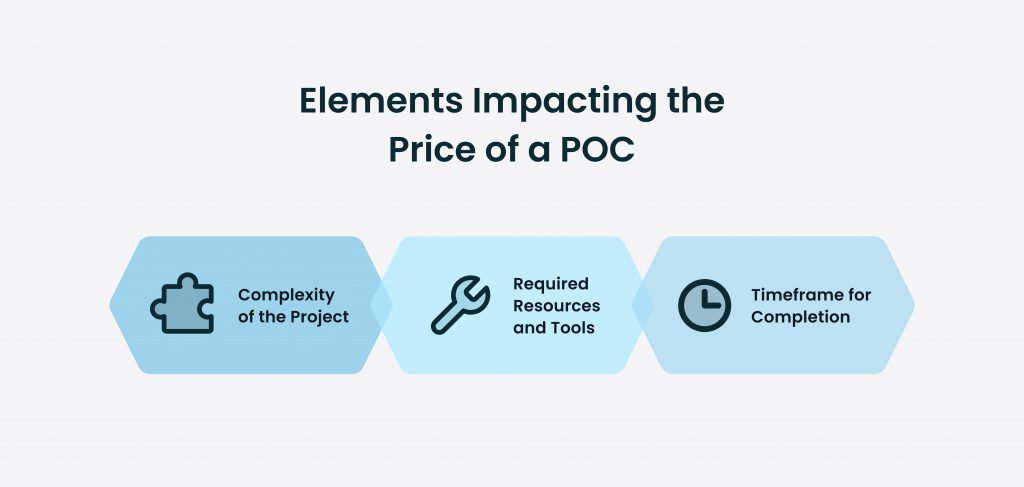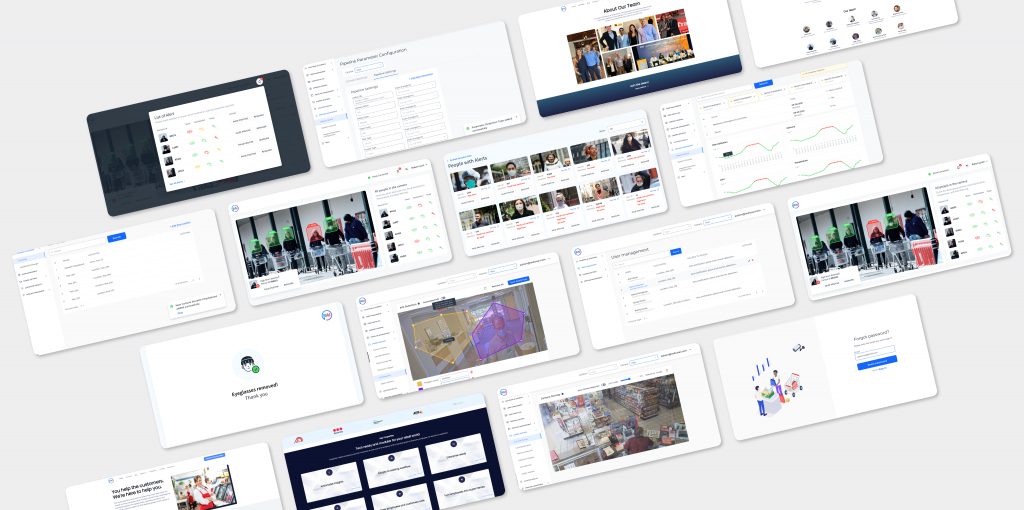According to statistics, 20% of businesses fail in their first year of operation, and one of the key reasons for this is the lack of market need for their solutions. One way to overcome this challenge is the development of Proof of Concept (POC). It is a pivotal validation step before committing substantial resources to a full project.
This article, presented by WeSoftYou, delves into the critical factors shaping the costs of POC development, guiding businesses in estimating expenses and understanding the financial impact of a successful POC.
Key Takeaways:
- WeSoftYou, an esteemed software development company, explores the intricacies of POC development costs, offering insights into estimation methods and the outcomes of a successful POC.
- The article covers the basics of POC, the factors influencing its cost, effective estimation strategies, ways to minimize expenses, and the financial benefits of a successful POC.
Understanding the Basics of a Proof of Concept (POC)
A Proof of Concept (POC) is a small-scale version of a project that aims to verify the feasibility and potential success of an idea. It allows businesses to test the waters, validate assumptions, and assess the practicality of their concept. POCs are typically implemented using limited resources and provide insights into the efficacy of the proposed solution.
As a software development company with a proven track record, WeSoftYou has witnessed the undeniable importance of POCs in business development:
- Conducting a POC helps identify and mitigate potential risks early in the development process.
- A POC reveals any potential bottlenecks, allowing for proactive problem-solving.
- A small-scale version of the project provides valuable insights into the feasibility of the proposed solutions.
- The POC phase fosters close collaboration between developers and stakeholders, ensuring a clear understanding of the project scope and objectives.
- A POC validates key assumptions with tangible evidence, making it easier to convince stakeholders and investors of the project’s potential success.
- Demonstrating the potential success through a POC increases the chances of securing funding and gaining stakeholder support.
As a result, you receive a tangible manifestation of an idea, allowing for visualizing potential before investing substantial resources.
Importance of a POC in Business Development
POCs provide a solid foundation for decision-making by offering tangible evidence of an idea’s viability. They help businesses gain valuable insights into customer needs, market acceptance, and technical feasibility. POCs also aid in securing funding, gaining investors’ confidence, and aligning stakeholders’ expectations.
Conducting a POC allows organizations to assess risks and rewards, making informed decisions to avoid costly mistakes. It also enables gathering feedback from potential customers, providing insights into their preferences and expectations. This feedback helps refine the final product, increasing its market success chances.
Factors Influencing the Cost of a POC
What influences the cost of developing a Proof of Concept (POC)? WeSoftYou navigates the complexities of POC development costs, discussing factors such as project complexity, required resources, tools, and timeframe for completion. Gain valuable insights into POC cost estimation and financial impacts for informed decision-making.

Several factors influence the overall cost of developing a Proof of Concept (POC). Understanding these factors will enable businesses to estimate the financial investment required accurately.
Complexity of the Project
The complexity of the project directly impacts POC development costs. Projects with intricate requirements, multiple integrations, or advanced functionalities may demand more time and effort, resulting in higher expenses.
Developing a POC for a new mobile app requiring seamless integration with various third-party APIs, complex user authentication mechanisms, and real-time data synchronization involves extensive coding, testing, and debugging, significantly increasing development costs. The project’s complexity also demands a specialized skill set from the development team, and hiring or training developers with these rare technical skills further adds to the overall expenses.
Required Resources and Tools
The selection of appropriate resources and tools significantly affects the POC’s overall cost. Complex projects may require specialized hardware or software, which can increase expenses.
For instance, developing a POC for an augmented reality application requires high-performance devices to render complex 3D graphics and process data in real-time, adding to hardware costs like powerful computers or VR headsets. Additionally, the choice of software tools and frameworks impacts costs, as advanced development frameworks or licensed software can be expensive. Cloud services and infrastructure needs, such as hosting and storage, further contribute to the overall POC cost.
Timeframe for Completion
The duration allocated for POC development is another crucial factor influencing costs. A shorter timeframe may require additional resources, expedited workflows, and potentially affect the quality of the output.
For example, if a business needs a POC developed quickly to showcase at an industry conference, the development team may need to work overtime or hire additional personnel, increasing costs. Conversely, a longer timeframe allows for a more relaxed development process, leading to higher-quality output but potentially prolonging the project and incurring additional expenses.
Estimating the Cost of a POC
Accurately estimating the cost of POC development lays the groundwork for a reliable project plan and budget allocation. Let’s explore the primary cost factors:
Cost of Manpower
One of the most significant cost contributors is the manpower required for POC development. The expertise and experience level of the team directly affects costs. Skilled professionals command higher rates, but their thorough understanding of the project requirements can lead to more efficient and effective results.
When estimating manpower costs for POC development, it’s essential to consider the various roles involved, such as project managers, software developers, designers, quality assurance testers, and other specialists. Each role requires specific skills, and costs will vary accordingly. Additionally, the project’s duration impacts manpower expenses—the longer it takes, the higher the costs. Balancing the project timeline with the budget is crucial for completing the POC successfully within the desired timeframe.
Cost of Technology and Tools
The adoption of technology and tools impacts the budget required for POC development. Depending on the project’s specific needs, licensing fees, software subscriptions, and infrastructure costs may vary.
When evaluating technology and tool costs, consider scalability and compatibility to save long-term expenses by avoiding significant future modifications. Additionally, factor in training costs to upskill the development team, ensuring effective use of resources and a successful POC.
Miscellaneous Costs
Other cost factors include data acquisition, user research, travel expenses, and unforeseen challenges. Data acquisition involves gathering relevant data, which may require purchasing from third-party providers or conducting surveys. Costs vary based on data complexity and volume.
User research, essential for understanding target needs, may involve consultants, focus groups, or usability testing, requiring budget allocation. Travel expenses for on-site visits and meetings include transportation, accommodation, and meals. A contingency budget addresses unexpected challenges, keeping the project on track.
Ways to Minimize POC Development Costs
While Proof of Concept (POC) development costs may be inevitable, businesses can employ certain strategies to optimize expenditure without compromising quality. By implementing the following approaches, companies can effectively manage their POC development costs:
Efficient Project Management
Effective project management is crucial for cost optimization. By establishing clear project objectives and milestones, assigning tasks efficiently, and continuously monitoring progress, businesses can identify potential roadblocks early on. This proactive approach reduces the need for costly rework and ensures that the POC development stays on track.
Moreover, efficient project management allows for better resource allocation, ensuring that the right people with the right skills are assigned to the project. This minimizes the risk of delays and unnecessary expenses caused by trial and error.
Choosing the Right Team
The selection of a competent and experienced team plays a pivotal role in cost management during POC development. Opting for a team with relevant expertise ensures that the POC is developed efficiently and accurately.
By choosing a team that has prior experience in similar projects, businesses can benefit from their knowledge and avoid common pitfalls. This reduces the need for extensive iterations and rework, ultimately saving costs.
Utilizing Cost-Effective Tools and Resources
Using cost-effective tools and resources significantly reduces POC development costs. Affordable alternatives, open-source libraries, frameworks, and templates save time and labor without compromising quality.
Efficient project management, the right team, and cost-effective tools streamline development and automate tasks, further minimizing expenses. Continuous evaluation and optimization ensure adaptation to changing project needs and market dynamics.
The Financial Impact of a Successful POC
When it comes to developing a new product or service, organizations often face the challenge of securing funding and attracting potential investors. Without tangible evidence, it can be difficult to convince stakeholders of the feasibility of an idea. However, a successful Proof of Concept (POC) can help address these concerns and increase the chances of obtaining financial support for the full-scale project.
Return on Investment
One of the key financial benefits of a successful POC is the potential for a high return on investment. By showcasing the viability and potential of an idea through tangible evidence, organizations can demonstrate to investors the value and profitability of the project. This can lead to increased funding opportunities and a higher likelihood of attracting potential investors who are willing to support the full-scale development.
Moreover, a successful POC can also help organizations build credibility and trust with investors. By proving that the concept has been thoroughly tested and validated, organizations can instill confidence in potential investors, increasing the chances of securing the necessary financial resources.
Long-Term Financial Benefits
Successfully validating a concept through a POC not only helps secure funding but also minimizes the risk of investing in projects that may not resonate with the market or meet customer needs. By conducting a POC, organizations can gather valuable feedback from potential customers and stakeholders, allowing them to make informed decisions about the viability and potential success of the project.
By identifying any flaws or limitations early on in the POC phase, organizations can make necessary adjustments and improvements before investing significant resources in full-scale development. This proactive approach reduces the risk of developing a product or service that fails to meet market demands, ultimately leading to long-term financial benefits.
Risk Mitigation and Cost Savings
Another significant financial benefit of a successful POC is the ability to mitigate risks and save costs. By thoroughly assessing the feasibility of an idea in the POC phase, businesses can identify and rectify any flaws or limitations early on. This proactive approach minimizes the likelihood of costly rework during the full-scale development phase, saving both time and financial resources.
Furthermore, a successful POC allows organizations to identify potential challenges and obstacles that may arise during full-scale development. By addressing these issues early on, organizations can develop effective strategies to overcome them, reducing the risk of unexpected costs and delays.
How can we help with Proof of Concept (POC) development?
At WeSoftYou, our commitment to delivering exemplary Proof of Concept (POC) development solutions has resulted in transformative experiences for numerous clients, including Radius.ai and Truveris. Through our dedicated teams and innovative approach, we’ve effectively addressed complex challenges and propelled our clients toward their goals. Let’s delve into how WeSoftYou’s expertise elevated two of the projects:
Truveris: Revolutionizing Healthcare SaaS

Truveris, a leading Healthcare SaaS platform, entrusted WeSoftYou with enhancing their capabilities in predictive analytics and performance improvement. Our collaboration aimed to drive transparency, affordability, and access throughout the pharmacy supply chain. Here’s how we made it happen:
-
Integrating Navigation System: We seamlessly integrated a navigation system into the platform, ensuring smooth user experiences and efficient navigation across key components.
-
Project Quality Support: Our team provided comprehensive project quality support, ensuring adherence to rigorous standards and impeccable performance throughout the development process.
-
Updating Library and Framework Dependencies: We diligently updated library, framework, and database dependencies to ensure optimal performance, security, and compatibility with evolving technologies.
-
Containerization of Microservices: Implementing containerization techniques, we optimized the platform’s scalability, flexibility, and resource management, laying the foundation for future growth.
-
Project Migration to Microservice Architecture: We orchestrated a seamless migration to a microservice architecture, enhancing agility, maintainability, and scalability while minimizing disruptions to operations.
Our efforts empowered Truveris with a robust, future-ready platform, poised to revolutionize the healthcare landscape with its predictive analytics capabilities and performance enhancements.
Radius.ai: Elevating Visitor Experience with AI Technology

Radius.ai entrusted WeSoftYou to revolutionize visitor experiences through innovative AI-powered solutions. Our collaboration aimed to amplify visitor experiences and ensure public safety across various spaces. Here’s how we achieved remarkable results:
-
Real-Time Tracking with Viztel™ AI Technology: Leveraging Viztel™ AI technology, we transformed existing vision-capturing devices into powerful tools for real-time tracking and analysis of visitor behavior within facilities.
-
Time Savings with Pre-screening Solution: Our pre-screening solution saved nursing staff significant time, enabling them to allocate resources more efficiently and focus on critical tasks.
-
Enhanced Differentiation and Tracking: We developed unique, anonymized numeric codes to differentiate between customers and staff, allowing for detailed tracking of customer journeys, behaviors, and preferences.
-
Advanced Real-Time Tracking Models: Our advanced real-time tracking models enabled precise tracking of customers in 3D space using standard 2D monocular security cameras, enhancing security and operational efficiency.
Through our partnership with Radius.ai, we’ve empowered businesses to gain invaluable insights into visitor behavior, optimize operational efficiency, and ensure a safe and seamless visitor experience.
Conclusion: Is Developing a POC Worth the Cost?
Considering the potential financial benefits and risk mitigation associated with POC development, the answer is a resounding “yes.” The initial investment required for developing a POC pales in comparison to the potential losses resulting from launching a full-scale project without proper validation. We at WeSoftYou strongly advocate for POC development as a crucial step toward ensuring project success.
For a free consultation or project estimation, feel free to contact WeSoftYou. Our experienced team is ready to assist you in bringing your ideas to life while minimizing costs and maximizing returns.
FAQ
A Proof of Concept (POC) is a demonstration or prototype that validates the feasibility and potential of a concept or idea. It is a small-scale project that aims to prove the viability of a product or service before investing significant resources into its development.
POC plays a crucial role in business development as it allows companies to assess the technical and commercial viability of their ideas. By building a POC, businesses can gather feedback, identify potential challenges, and make informed decisions about whether to proceed with a full-scale development or make necessary adjustments.
The complexity of a project directly impacts the development costs of a POC. Projects with higher complexity require more time, resources, and expertise to develop a functional prototype. Complex projects often involve intricate algorithms, advanced technologies, or integration with existing systems, which can significantly increase the development costs.
Businesses can minimize POC development costs by carefully scoping the project and focusing on the essential features that need to be demonstrated. By prioritizing the key functionalities and avoiding unnecessary complexities, businesses can streamline the development process and reduce costs. Additionally, leveraging existing frameworks, tools, and open-source technologies can also help minimize development expenses.
Developing a POC is often worth the cost as it allows businesses to mitigate risks and make informed decisions. By investing in a POC, companies can validate their ideas, gather valuable insights, and identify potential issues early on. This can save significant time and resources in the long run by avoiding costly mistakes and ensuring that the final product meets the market’s needs and expectations.
For a free consultation or project estimation, contact WeSoftYou today!





















